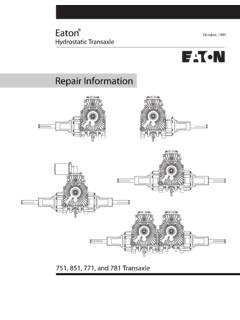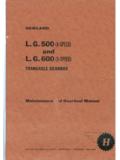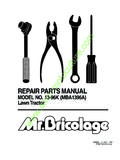Transcription of THE DG 300 MARK 2 5-SPEED TRANSAXLE GEARBOX UNIT
1 THE DG 300 MARK 2 5-SPEEDTRANSAXLE GEARBOX UNITThe Mark 2 DG300 GEARBOX has five forwardratios and reverse. It is designed for usewith rear engine competition cars having acapacity of up to 4% one final drive ratio is used. Since thedrive is indirect at all times, any change inratio can be made through the GEARBOX . Thedrive is taken from the clutch shaft to thespiral bevel final drive via straight cutgears. Gear change is effected by non-syn-chronised face dogs. Ratios can be changedwithout removing the unit from the chassis,and all requirements can be met from ourextensive range of gears.
2 All ratios exceptbottom are inter-changeable, and may bearranged in any differential and crown wheel assemblyis mounted on two taper roller bearingslocated in the side plates and adjustable tocorrect pre-load by shins. Output shafts arealso mounted in the side plates, and lip oil seals are gears run directly on caged needle rollerbearings, and each gear and bearing revolvesas an assembly. Heat treated nickle-chromesteel is used for all gears and shafts. Selec-tor forks are cast in aluminium bronze, andcasings in magnesium differential is of Limited Slip design,the unit normally supplied being the Camand Paw1 GEARBOX unit is lubricated by oil splash,and the final drive by pump.
3 The pump islocated in the main case, and is fed via afilter which can be withdrawn from the out-side of the case. The oil is piped out of themain case on the righthand side and returnsvia external piping, thus providing for thefitting of an oil cooler. The latter is stronglyrecommended to ensure that oil temperaturedoes not exceed its maximum ofThe gear change rod is mounted low down onthe right hand side. The clutch is operatedby steel. fork and push-rod - accepted as thesimplestand most reliable system, es-pecially with monocoque chassis.
4 The push-rod is actuated from a slave cylinder mountedon the side of the main general configuration of the DG 300 Mark 2 Series provides the maximum utilisa-tion of power allied to minimum weight forthe power required to be Specification Gear rod either side ofneutral for forwardgears. forward for reverseGear rod rotates total. 2 435 Oil FillerOil of gear Dimensions in inches2 IndexBacklash, adjusting ..Bearing Carrier (Main)..Bearing Carrier (Clutch Shaft..BearingsLayshaft and pinion, frontLayshaft and pinion, tailClutch Rings.)
5 Clutch Shaft..Crown Wheel..Crown Wheel & Pinion, setting upDifferential unit , RemovalDifferential unit , DismantlingEnd Case ..Filter.. GEARBOX unit ..Gear Ratios, changing ..Hubs..Layshaft ..General noteson maintenanceand overhaulPAGE15, 16599, 1555913, 1515913513555, 77 Only genuineHewland spares should beused as replacements. These are manufac-tured in our own workshops to the finetolerances necessary, and rigorously inspect-ed and tested:New nuts and gaskets should always beused on case and Diff. CompartmentOil, capacities and type.
6 Oil pump ..Oil Filter ..Pinion.. -..Plungers ..pre-load, adjusting..Reverse Idler Gear..Seleetor Finger ..Selector Forks, removal ..Selector Forks, setting upSelector heads..Selector Rods..Setting up + ..13, .8, .9, 13, ..5, ..5, .5, 7 Crown Wheel & Pinion ..15 Selector Forks ..7 Side Plates, removal..9 Side Plates, Dismantling..13 Technical specification ..2 When warming the outside of the case, keepthe blowlamp moving. Do not overheat. Testwith a spot of moisture, which will bounceoff when the case is hot refilling with oil, put half the quantityinto each filler hole.
7 Never put all the oil inone oil CapacityType of OilDG 300 Mark 2118 lbs3% 80 or90 f;..3 The GEARBOX unitREMOVING THE UNITEND the eight 5/16 UNF Nyloc nuts andwashers from the end cover. Take off coverand the split pins from the castellatedpinion and layshaft the heads of the two outside selectorrods, thus engaging the gears. This locks thegear box by engaging 2 the pinion nut, (left hand thread) andslacken off the lay shaft nut, (conventionalright hand thread)Now withdraw the two outside selector rods,to disengage the the ten 5/16 UNF nuts a plastic mallet, tap the bearing carrierand remove it from the main case, completewith lay-shaft assembly and gear train.
8 Sup-port the gears,hubs and clutch rings withthe hand, as they come off the GEARBOX unit is now completely in reverse order to GEAR RATIOSWhen changing a gear ratio, take off the slack-ened layshaft nut and remove the layshaft fromthe bearing carrier. Gears are exchanged in pairs- one from the layshaft and one from the pinionshaft. Each gear is etched with two sets ofnumbers. The first is the number of its ownteeth. The second is the number of teeth on itsmating is essential that gears should be correctlypaired according to these THE GEAR hubs, clutch rings and gears.
9 Washand inspect for wear and cracks, giving part-icular attention to the clutch forks for heavy or uneven wear, andtest for excessive play between forks andclutch forks are not to be stripped, check thatnuts are tight and properly tabbed. the three allen cap screws (36) andtake out the to)Selector Rod Springs andballs (35 &34 . Then take out the threeSelector Rods, one at a time, followed by thebottom balls and the 3/8 UNC allen cascrew (44) andpush out the locking slugs.
10 (43)Inspect pinion and layshaft tail bearings andrenew if necessary. To remove, warm upsurrounding In layshaft bearingcheck for wear on steel sleeve in layshaftbearing and renew if in reverse order to above, subjectto the following:-10. When replacing bottom balls and springs, setup to correct height. About one-third of theball should be exposed. Continue by insertinglocking slugs and selector rods, then topballs and hub renewed should be identical inlength with the original. If replacing all hubs,or main bearing carrier, check that overall_ _-__ _TO REMOVE SELECTOR FINGER HOUSING (5)4.





